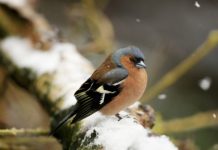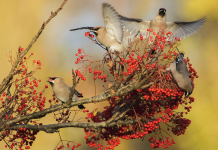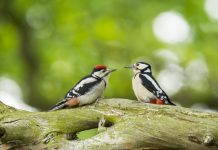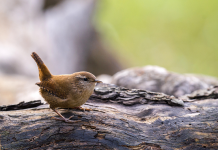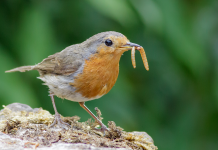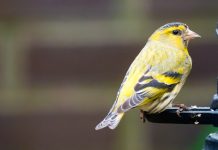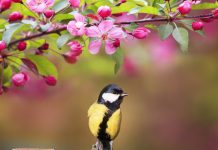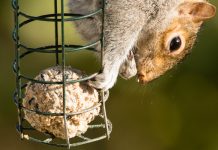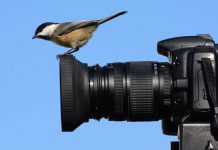You don’t need a large garden to feed birds. With a stick-on window bird feeder you can enjoy watching them from the comfort of your own home. A great activity for the whole family, children especially love watching wild visitors up close as birds swoop in to enjoy high energy snacks.
Here’s everything you need to know about window feeders including the different types available, the birds you can expect to see, what to feed them, and how to keep your flying friends coming back for more.
What is a window bird feeder?
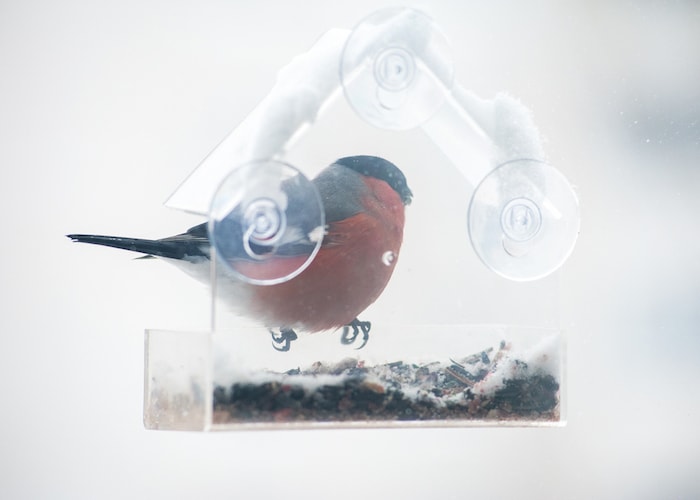
Image source: Shutterstock
Stick-on window feeders attach directly onto the glass of a window pane with suckers. Simply fill with bird food, stick to a window of your choice and sit back and watch.
For a good seal, make sure the glass and the suction cups are both clean. Press any remaining air bubbles out after you have mounted the feeder.
There are several different types of window bird feeders. The main ones include:
- Tube feeder: Often with a couple of feeding ‘ports’, these seed feeders are perfect for attracting a wide variety of perching birds such as tits, finches and sparrows.
- Tray feeder: With an open tray feeder, you can use a wider variety of feed. Tray feeders are perfect for birds who prefer a flat surface, such as robins.
- Tray with roof: The advantage of a roof is that it will keep your seed dry, so that it doesn’t rot, and keep the snow off in the winter when feeding is vital.
- Basket ball feeder: A basket ball feeder is perfect for suet fat balls. You can also use them to hold other foods too, such as fruit.
Six benefits of a window feeder
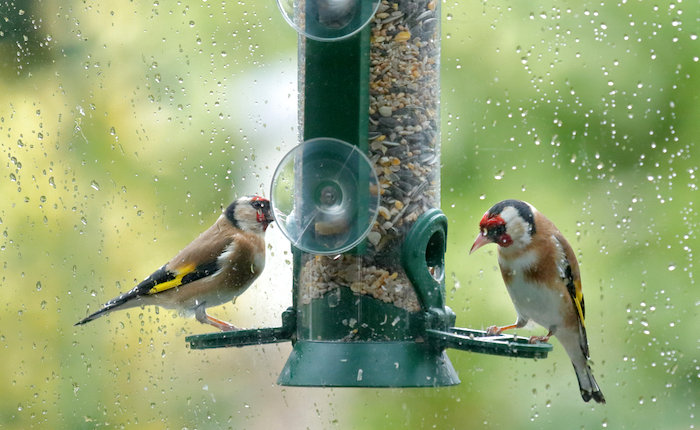
Image source: Shuttterstock/Roel Slootweg
The Woodland Trust says: “Not only are birds lovely to watch, but by supplementing their wild diet, you’re actually helping to conserve their populations.”
Providing food via a window feeder allows you to view birds close up. It’s like your own wildlife show right outside your window! Here are 6 of the main benefits of a window bird feeder:
- Closer to nature: Get a close up view of wild birds as they feed, from the comfort of your own home – whatever the weather!
- Great for small spaces: Window feeders are ideal if you have a small garden, patio, balcony – or no outside space at all.
- Great for families: Children love watching garden birds up close, and learning more about nature. Perfect if your kids are taking part in the Big Schools’ Birdwatch. And watching birds is healthier than spending hours watching a screen!
- Great for photographers: Being up close and personal means you can get some great shots. Position a camera near to the feeder – or, if you’re technically minded, you could live-stream footage!
- Attract small birds: A window feeder, especially one with a roof, will attract small garden birds only – such as tits, robins, sparrows, wrens and goldfinches.
- Deter predators: Window feeders offer some protection against predators such as squirrels and cats, since they’re hard for them to reach.
Which native birds will visit window feeders?
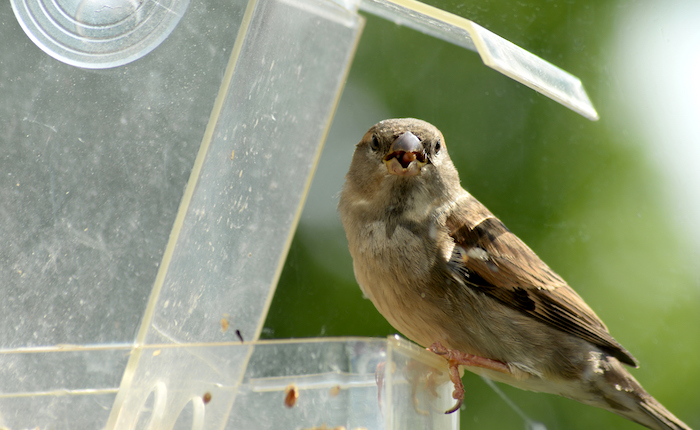
Image source: Getty Images/pappamaart
You can attract a wide variety of birds to your window feeder. According to the British Trust for Ornithology’s annual Garden Bird Feeding Survey, the range of birds who will visit your garden has grown by over 50% since the 1970s!
You can expect to see birds like robins, nuthatches, wrens, house sparrows, blackbirds, blue tits, starlings, great tits, goldfinches and song thrushes. Some species are bolder than others, but the type of birds you attract also depends on the type of feeder – and the food you provide.
Spotting the different garden birds who visit your window feeder is not only entertaining for children, it’s educational. If you’re lucky enough to see a bird that you’re not familiar with, check out the Somerset Wildlife Trust’s online bird identifier to try and work it out.
What’s the best bird feed to use in a window feeder?
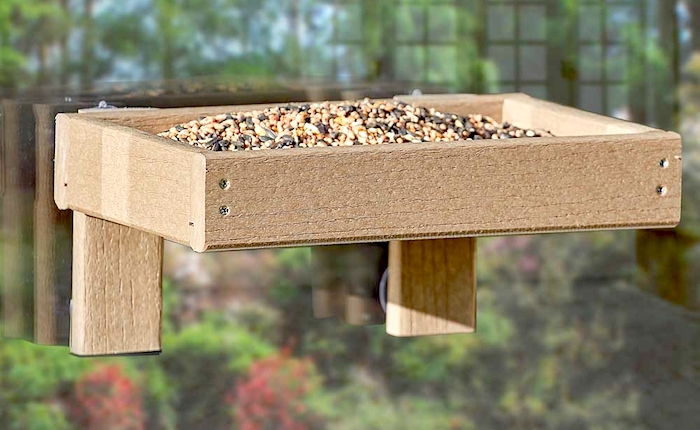
Image source: Happy Beaks
Small seeds, like millet, attract house sparrows, dunnocks and finches. Larger foods, like peanuts and sunflower seeds are favoured by tits and greenfinches.
Think about the type of bird you want to attract, and what type of feed your chosen window feeder is best suited to. As a general rule, the more varieties of food you offer, the more species you’re likely to attract. Here’s a list of the main foods and which birds like them best:
- Bird seed mixes: Suitable for a wide range of birds, including tits, finches, dunnocks, house sparrows, robins and starlings. Great for tube feeders.
- Niger seed: A favourite of goldfinches, this is particularly good for tray window feeders, since they’re so small they can fall through seed hoppers.
- Mealworms: A high calorie treat for many birds, especially robins, and a great replacement for naturally occurring foods, which aren’t always available.
- Suet fat balls: Popular with members of the tit family and starlings, but will also attract sparrows, blackbirds and robins. An ideal winter feed.
- Fruit: fresh fruit provides a high energy treat for many birds. You can also use dried fruits, which are particularly enjoyed by blackbirds, song thrushes and robins.
It takes courage to come right up to the window – so give your garden birds an incentive by putting out their favourite food to attract them. And make your window feeder the only place they can get it!
How do you clean and maintain a window feeder?
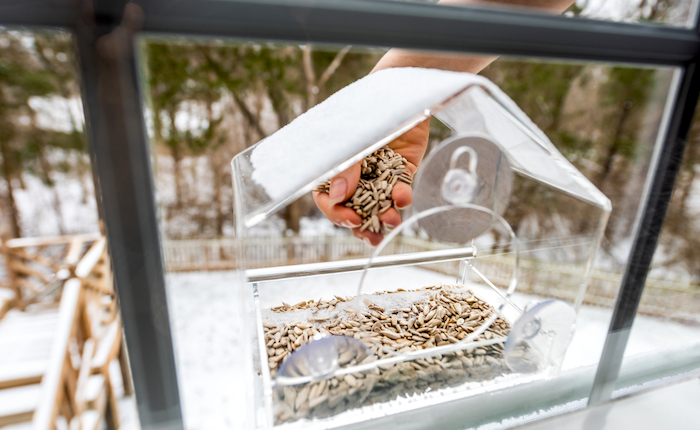
Image: Shutterstock/Andriy Blokhin
Maintain your window feeder by replenishing the food regularly. Your birds will go elsewhere without a continuous supply of feed – but it’s also important for bird health. Bird food that has ‘gone off’ can allow harmful bacteria to grow and cause disease.
Good feeder hygiene is important all year round, but especially during the summer months, since the warm weather can make food go off more quickly. Keep your window feeder clean, so it’s a safe environment for both your family and your feathered friends – and keep the surrounding area clean and free from droppings too. The Scottish Wildlife Trust advises: “You should clean your feeders at least once a month, or more regularly if they are busy feeders.”
Remove your feeder from the window, and clean it outdoors with a small amount of disinfectant, or specific bird feeder cleaning products. Use separate brushes for the job, and always wear gloves and wash your hands after you’re done. Allow the feeder to dry thoroughly before refilling with food and re-attaching to your window.
Sticking a bird feeder directly onto your window will not only create lots of interest and entertainment for the whole family – you’ll be helping your local wildlife thrive too.
Have you got a window feeder? What birds have you seen visiting it? Let us know over on our Facebook page!
Lead image: Kingfisher window mounted bird feeder from Happy Beaks

